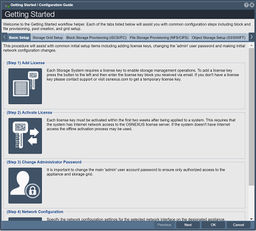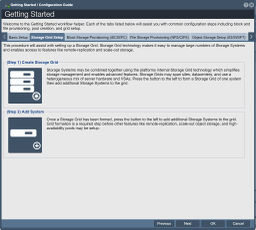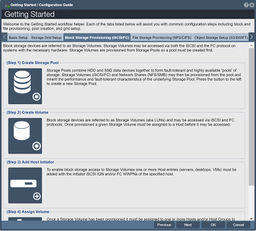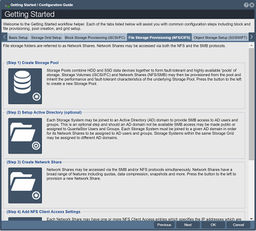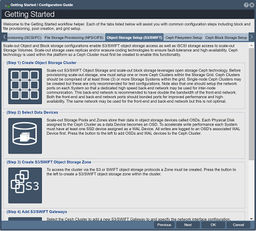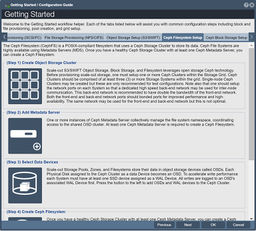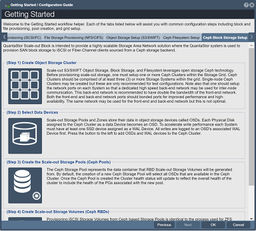Overview (Getting Started)
Getting Started/Configuration Guide
Navigation: Storage Management --> Storage System --> Storage System --> Getting Started (toolbar)
Contents
General Settings
This procedure will assist with the initial setup items including adding license keys, changing the 'admin' user password and making initial network configuration changes.
-Step one helps you Add a license.
-Step two helps you Activate a license.
-Step three helps you change the Administrator's Password.
-Step four helps you setup the Network Configuration.
Storage Grid Setup
This procedure will assist with setting up a Storage Grid. Storage Grid technology makes it easy to manage large numbers of Storage Systems and enables access to features like remote-replication and scale-out storage.
-Step one helps you Create a Storage Grid.
-Step two helps you Add a System.
Block Storage Provisioning (iSCSI/FC)
This procedure will assist with setting up a Storage Grid. Storage Grid technology makes it easy to manage large numbers of Storage Systems and enables access to features like remote-replication and scale-out storage.
-Step one helps you Create a Storage Grid.
-Step two helps you Add a System.
File Storage Provisioning (NFS/CIFS)
File storage folders are referred to as Network Shares. Network Shares may be accessed via both the NFS and the SMB protocols.
-Step one helps you Create a Storage Pool.
-Step two helps you Setup an Active Directory (optional).
-Step three helps you Create a Network Share
-Step four helps you adjust NFS Client Access Settings.
-Step five helps you adjust SMB Client Access Settings.
Object Storage Setup (S3/SWIFT)
Scale-out Object and Block storage configurations enable S3/SWIFT object storage access as well as iSCSI storage access to scale-out Storage Volumes. Scale-out storage uses replicas and/or erasure-coding technologies to ensure fault-tolerance and high-availability. Ceph technology is used within the platform so a Ceph Cluster must first be created to enable this functionality.
-Step one helps you Create an Object Storage Cluster.
-Step two helps you Select Data Devices.
-Step three helps you Create an S3/SWIFT Object Storage Zone.
-Step four helps you Add an S3/SWIFT Gateways.
-Step five helps you Add S3/SWIFT Users.
Ceph File System Setup
The Ceph Filesystem (CephFS) is a POSIX-compliant filesystem that uses a Ceph Storage Cluster to store its data. Ceph File Systems are highly available using Metadata Servers (MDS). Once you have a healthy Ceph Storage Cluster with at least one Ceph Metadata Server, you can create a Ceph Filesystem.
-Step one helps you Create an Object Storage Cluster.
-Step two helps you Add a Metadata Server.
-Step three helps you Select Data Devices.
-Step four helps you Create a Ceph File System.
-Step five helps you Create a Network Share.
Ceph Block Storage Setup
QuantaStor Scale-out Block is intended to provide a highly scalable Storage Area Network solution where the QuantaStor system is used to provision SAN block storage to iSCSI or Fiber-Channel clients sourced from a Ceph storage backend.
-Step one helps you Create an Object Storage Cluster.
-Step two helps you Add a Metadata Server.
-Step three helps you Select Data Devices
-Step four helps you Create a Ceph File System.
-Step five helps you Create a Network Share.
